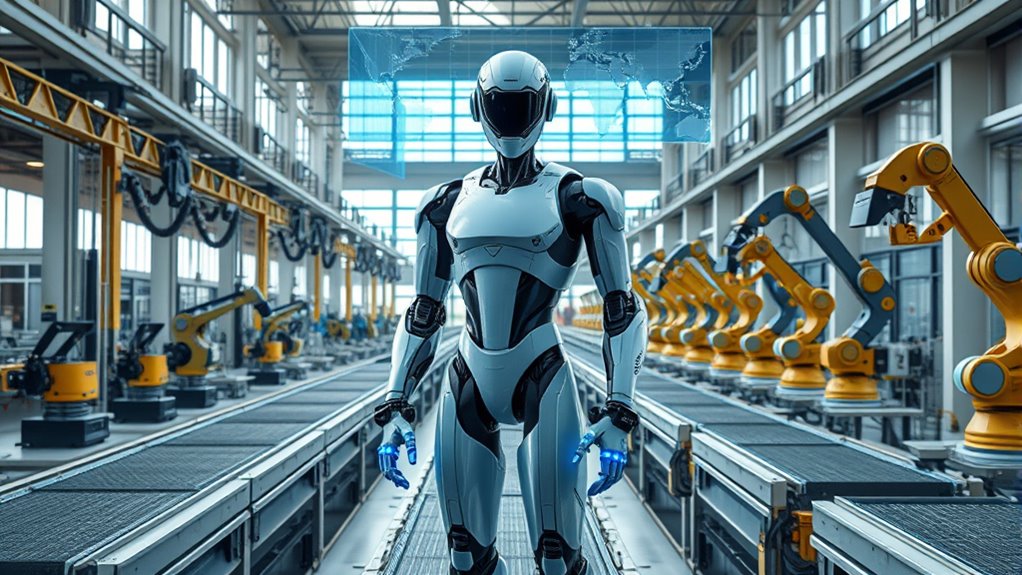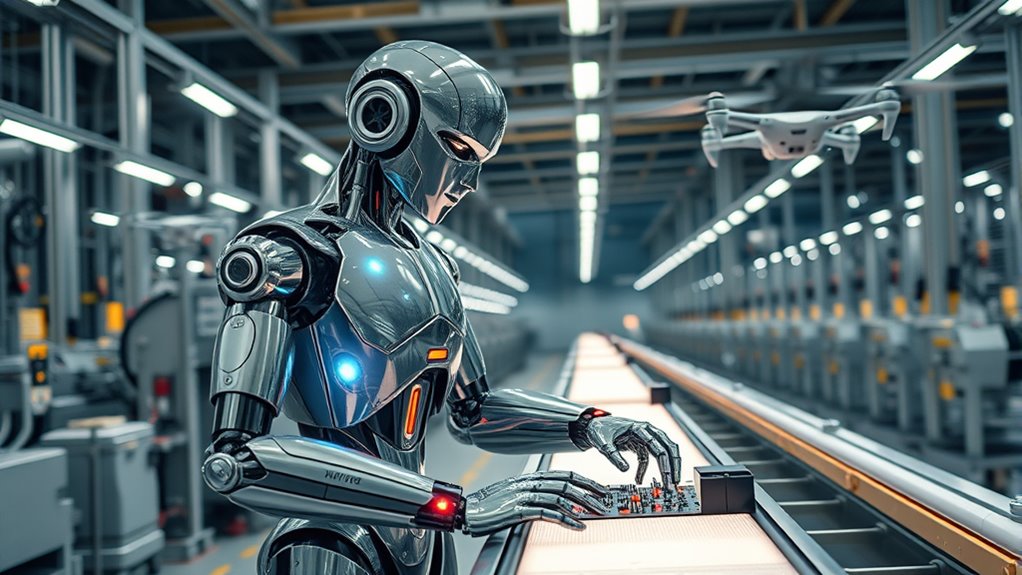By 2025, robotics and automation are hitting major milestones, transforming industries with faster, more precise work and smarter AI integration. You’ll see increased use of robots performing visual and complex tasks, with a focus on ethical decision-making and transparency. As jobs evolve, new opportunities in tech-focused roles emerge, but ethical considerations remain key for societal trust. If you want to understand how these changes shape industries and the workforce, keep exploring what’s next.
Key Takeaways
- Significant advancements in robotics have enabled faster, more accurate automation across industries, transforming manufacturing, logistics, and healthcare.
- Ethical AI integration ensures decision-making transparency, reducing bias and building trust in robotic systems by 2025.
- Workforce transformations include reskilling initiatives, with new roles emerging in oversight, maintenance, and programming of autonomous systems.
- Companies prioritize ethical standards and societal impacts, fostering inclusive automation ecosystems and long-term acceptance.
- Strategic focus on innovation aligned with ethical considerations drives sustainable growth and technological milestones in robotics by 2025.

Have you noticed how robotics are transforming industries at an unprecedented pace? As automation becomes more ingrained in daily operations, it’s clear that the integration of AI and robotics is reshaping the way we work and produce. One of the most pressing concerns you might have is how AI ethics come into play. As robots take on more complex tasks, questions about decision-making transparency, bias, and accountability grow louder. You need to consider whether these systems are designed ethically, ensuring they don’t perpetuate inequalities or make harmful choices. Developers are now faced with the challenge of embedding ethical standards into AI algorithms, making sure that robotics act in ways that align with societal values. This focus on AI ethics isn’t just about avoiding harm; it’s about building trust in automated systems so that they’re accepted and integrated smoothly into the workforce. The role of color accuracy in image rendering is also increasingly crucial as robots are employed in visual tasks, emphasizing the need for precise calibration and fidelity.
The workforce impact of these technological shifts is profound. You may notice that jobs once deemed secure are now evolving or even disappearing, replaced by robots capable of performing tasks faster, cheaper, and more accurately. While this automation can lead to increased productivity and safety, it also raises concerns about job displacement. Workers need to adapt by gaining new skills that complement robotic systems rather than compete with them. Industries are increasingly investing in training programs to help their employees transition into roles that require oversight, maintenance, or programming of robotic systems. This shift isn’t just about replacing human effort; it’s about transforming roles and creating new opportunities in tech-driven fields. For some, this transition might be challenging, especially for those in roles that are most vulnerable to automation. However, others may find new pathways emerging, especially in areas like robotics management, AI ethics oversight, and system integration.
You also have to consider how businesses are balancing automation’s benefits with its societal implications. Companies that prioritize ethical AI use and workforce impact are more likely to succeed in the long run. They recognize that fostering trust and ensuring fair treatment of workers aren’t just moral imperatives—they’re strategic advantages. As robotics continue to advance in 2025, it’s essential for you to stay informed about these developments. Understanding the interplay between AI ethics and workforce impact can help you navigate a rapidly changing landscape, whether you’re a worker, a manager, or a consumer. The future of robotics isn’t just about technological achievement; it’s about creating an ecosystem where innovation benefits everyone, ethically and inclusively.
Frequently Asked Questions
How Will Robotics Impact Global Employment Rates in 2025?
You’ll see robotics cause some job displacement, especially in repetitive tasks, but it’ll also create new opportunities. As automation advances, you’ll need to adapt to skill shifts, focusing on tech and problem-solving abilities. While some roles fade, others emerge, making it essential for you to stay flexible and continuously learn. Ultimately, robotics will reshape employment, demanding proactive efforts from you to thrive in this evolving landscape.
What Safety Regulations Govern Autonomous Robot Operations?
You need to follow strict safety regulations for autonomous robot operations, focusing on robot safety and regulatory compliance. These regulations include standards set by organizations like OSHA, ISO, and ANSI, which require safety features such as emergency stops, sensors, and fail-safe systems. Ensuring your robots are compliant helps prevent accidents, protects workers, and maintains legal standards. Regular safety assessments and updates are essential to stay aligned with evolving regulations.
How Do Robots Adapt to Unpredictable Environments?
You see robots navigate chaos with ease, thanks to sensor adaptability and learning algorithms. They process unpredictable changes in real-time, adjusting their actions swiftly. While humans rely on intuition, robots learn from new data, refining responses continually. This combination helps them handle unforeseen obstacles, making them more effective in dynamic environments. By constantly updating their understanding, robots stay resilient, ensuring safety and efficiency even when faced with the unexpected.
What Are the Ethical Concerns Surrounding Ai-Driven Automation?
You need to take into account AI bias, which can lead to unfair decisions, and privacy concerns, as AI automation often collects sensitive data. These ethical issues may affect trust and societal acceptance of automation. As you develop or implement AI systems, ensure transparency, fairness, and robust data protection. Addressing these concerns proactively helps prevent misuse and builds confidence in AI-driven automation’s responsible use.
How Affordable Will Advanced Robots Become for Consumers?
You’ll find that advanced robots are becoming more affordable thanks to cost reduction efforts, making them more accessible to consumers. Prices are expected to drop considerably, so you won’t have to break the bank to own smart automation devices. As technology advances and production scales up, these innovations will be within your reach, turning what once seemed like a pipe dream into a practical reality for everyday use.
Conclusion
As you look ahead, it’s clear robotics will continue transforming your world. By 2025, over 35% of industries are expected to integrate advanced automation, boosting efficiency and safety. Imagine how your daily life and workplace will evolve with these innovations—faster, smarter, and more connected than ever. Embrace the future of robotics, because it’s not just coming; it’s already here, shaping the way you work, live, and interact every day.










